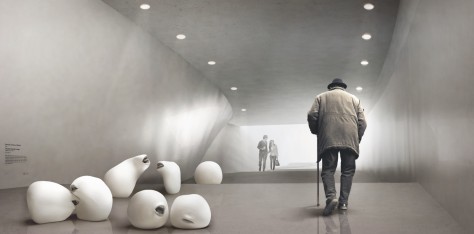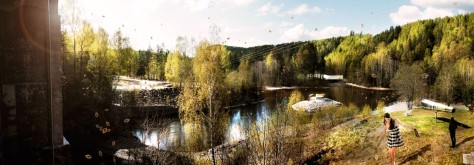
The new Kistefos Museum is located in the scenic Kistefos Sculpture Park established in late 90s – today home to works by internationally renowned contemporary artists including Anish Kapoor, Olafur Eliasson, Fernando Bottero and Elmgreen & Dragset.

The museum site is situated by the river Randselva in Jevnaker, just an hour north of Oslo. Built around a historical paper mill, the sculpture park occupies both embankments of the river, with an old bridge serving as the only crossing.

BIG’s proposal is conceived as a simple beam that spans the Randselva to connect the two edges of the site, becoming a second bridge for the Sculpture Park. A simple twist in the building’s volume allows the bridge to lift from the lower forested area towards the south, up to the hillside area in the north.

This creates a series of interconnected spaces: a vertical stack of galleries for media, paintings, and sculpture to the south – and a horizontal, open gallery, ideal for sculptures and large installations to the north.

The warped geometry of the building volume merges the vertical and horizontal in a single motion, forming a fanning staircase inside. The staircase doubles as an informal seating area, as well as an ideal space for video projections, performance art, and other such events.

The skylight of the gallery morphs from being vertical along the east façade to horizontal at the top of the southern end of the building, creating the combination of a sky-lit gallery, a side-lit gallery and a dark gallery.

Visitors enter the museum through a triple height space at the southern end of the building, where the information center, museum shop, and other facilities are located.

From here, guests will have a clear view through the space to the other end of the museum, where a cafe will let guests enjoy snacks while taking in views of the historical pulp mill and surrounding landscape. In the summertime, the cafe service area spills onto the plateau just outside.

The façade is kept in refined, precisely articulated materials. The non-glazed portion is constructed of brushed stainless steel, while the glazing consists of large insulated glass panels with a reflective UV film to keep out all art-damaging light and 75% of the solar gain.

Electrical solar shading will be integrated in the façade’s framing system to offer both translucent shading and complete darkness. Providing access to indirect daylight as well as light-sealed, artificially lit environments, different media and events (such as video installations, museum-wide shows and performances) are accommodated in the design. Source by Bjarke Ingels Group.

Location: Scandinavia
Architects: Bjarke Ingels Group
Partners in Charge: Bjarke Ingels, David Zahle
Project Leader: Brian Yang
Project Team: Alina Tamosiunaite, Christian Dahl, Ryohei Koike, Balaj Alin Iulian, Marcelina Kolasinska, David Tao, Jan Magasanik, Tiina Juuti, Kamilla Heskje, Eva Seo Andersen, Finn Nørkjær, Andreas Klok Pedersen
Collaborators: AKT II, Max Fordham, Davis Langdon, GCAM, MIR
Client: Kistefos Museum
Project type: Invited Competition
Area: 1400 m2
Year: 2015
Images: Courtesy of Bjarke Ingels Group












